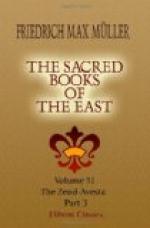The first twenty-five years of this century were void of results, but the old and sterile discussions as to the authenticity of the texts continued in England. In 1808 John Leyden regarded Zend as a Pracrit dialect, parallel to Pali; Pali being identical with the Magadhi dialect and Zend with the Sauraseni. In the eyes of Erskine, Zend was a Sanscrit dialect, imported from India by the founders of Mazdeism, but never spoken in Persia. His main argument was that Zend is not mentioned among the seven dialects which were current in ancient Persia according to the Farhang-i Jehangiri, and that Pahlavi and Persian exhibit no close relationship with Zend.
In Germany, Meiners had found no followers. The theologians appealed to the “Avesta,” in their polemics, and Rhode sketched the religious history of Persia after the translations of Anquetil.
Erskine’s essay provoked a decisive answer from Emmanuel Rask, one of the most gifted minds in the new school of philology, who had the honor of being a precursor of both Grimm and Burnouf. He showed that the list of the Jehangiri referred to an epoch later than that to which Zend must have belonged, and to parts of Persia different from those where it must have been spoken; he showed further that modern Persian is not derived from Zend, but from a dialect closely connected with it; and, lastly, he showed what was still more important, that Zend was not derived from Sanscrit. As to the system of its sounds, Zend approaches Persian rather than Sanscrit; and as to its grammatical forms, if they often remind one of Sanscrit, they also often remind one of Greek and Latin, and frequently have a special character of their own. Rask also gave the paradigm of three Zend nouns, belonging to different declensions, as well as the right pronunciation of the Zend letters, several of which had been incorrectly given by Anquetil. This was the first essay on Zend grammar, and it was a masterly one.




